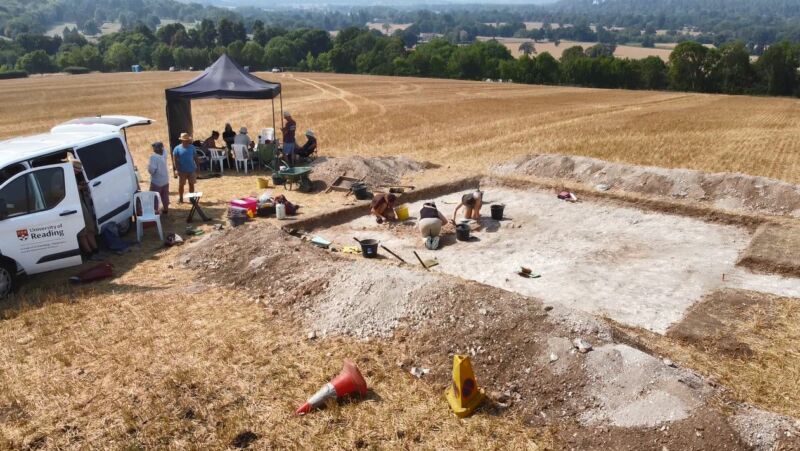spears are great for social distancing —
The burial hints at the complex political landscape of post-Roman Britain.
Kiona N. Smith
–

University of Reading
The Berkshire hilltop where metal detector hobbyists found a warrior’s grave was supposed to have been an unimportant patch of borderland between neighboring tribes 1,400 years ago. But the warrior, buried with a view of the Thames River valley and all the trappings of power and status, tells a different story. His presence suggests that this quiet bit of English countryside may have been in the thick of the power struggles that rippled across Britain in the decades after the Roman Empire receded.
Around 400 CE, Rome abandoned its far-flung colony in Britain and withdrew its troops back to the mainland of Europe. Not long after that, Germanic warriors from the continent swept onto the island: the forerunners of the Anglo-Saxons. Archaeologists don’t entirely agree on whether the Anglo-Saxons arrived as a huge wave of settlers who overwhelmed and replaced the native Britons, or whether only a smaller number of warriors came to Britain to seize power in the wake of Rome’s departure. Either way, they reshaped British culture and society over the next several centuries.
The Anglo-Saxon tribes banded together under strong military leaders. Over time, some of those groups would coalesce into the medieval Anglo-Saxon kingdoms of Wessex, Mercia, and Kent. Others faded from power, wiped out or absorbed by their rivals. And that brings us to the stretch of the Thames River between Oxford and London and the man archaeologists have nicknamed the Marlow Warlord.
A formidable warrior
In life, the man would have been a towering figure, especially in early medieval Europe, where people were smaller on average than modern populations. Based on his skeleton, he would have been around 1.8 meters (6 feet) tall. Through forensic study and isotopic analysis, University of Reading archaeologist Gabor Thomas and his colleagues expect the bones to tell them more about the man’s age at death, how he died, what he ate, and where he lived.
But the man was clearly a warrior, and he wielded power and status along with his fine sword and iron-tipped spears. The sword lay in a scabbard of wood and leather, decorated with elaborate bronze fittings. Elsewhere in the grave, archaeologists unearthed bronze and glass bowls, two iron spearheads, and the metal fittings you’d expect to find on a rich man’s clothes in early Anglo-Saxon England. The finds date to roughly the 500s CE.
“The nature of his burial and the site with the views overlooking the Thames suggest he was a respected leader of a local tribe and had probably been a formidable warrior in his own right,” said Thomas.
A lost domain
That came as a bit of a surprise to archaeologists, because the mid-Thames basin—the area along the river between modern-day Oxford and London—wasn’t supposed to have had local tribes with important military leaders at the time. Most historians and archaeologists had assumed the area was just a border between two powerful neighboring tribes, not the home of a group with its own political and military power to wield.
“This is the first burial of its kind found in the mid-Thames basin, which is often overlooked in favor of the Upper Thames and London,” said Thomas. “It suggests that the people living in this region may have been more important than historians previously suggested.”
Eventually, the Marlow Warlord’s domain was probably absorbed into the larger kingdoms coalescing nearby, but his grave is a reminder of how murky our view of Britain is in the years after Rome.
A grave situation
The find was also a lucky break. Although the Marlow Warlord may once have lain beneath a barrow or mound, today the burial is relatively shallow, which means it could easily be destroyed by farming. In fact, it was shallow enough for hobbyists with metal detectors to find and unearth the fragile bronze bowls that had been placed in the grave.
Normally that would be the beginning of a horror story for archaeologists—the kind that ends with important clues about the past sitting on someone’s mantle or getting funneled into the black market. But Sue and Mick Washington, who discovered the site in 2018, weren’t looters. They immediately called the Portable Antiquities Scheme, a British Museum program that records small archaeological finds by members of the public.
The two iron spearheads tipped off the PAS archaeologists that the site was probably an early Anglo-Saxon grave, and in August 2020, archaeologists from the University of Reading excavated the grave and conducted a geophysical survey of the surrounding area. Artifacts from the grave are being conserved and will go on display at the nearby Buckinghamshire Museum.
“This is a great example of archaeologists and metal detectorists working together,” said PAS archaeologist Michael Lewis. “Especially important is the fact that the finders stopped when they realized they had discovered something significant and called in archaeological assistance. By doing so, they ensured much more could be learned about this interesting burial.”

